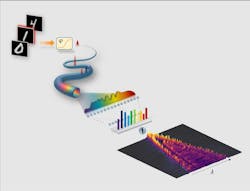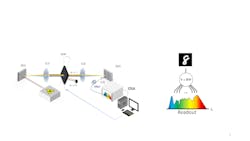Researchers from Tampere University in Finland and France’s Marie and Louis Pasteur University have demonstrated that laser light within highly nonlinear thin-glass optical fiber essentially mimics how AI processes information.
“Our method introduces a novel approach to optical computing,” says Mathilde Hary, a doctoral researcher at Tampere. “The motivation behind our research is to mitigate traditional electronic limitations.”
Their approach implements an extreme learning machine (ELM), a type of machine learning system known for fast and efficient learning rates that uses a highly nonlinear fiber to enable ultrafast, real-time computation (see video).
The ELM system builds on basic principles, including avoiding complex training methods such as backpropagation. It bridges the concepts of reservoir computing and optical neural networks using nonlinear propagation in fibers as a computational medium. The team aims to extend previous proof-of-concept optical ELMs by providing a quantitative framework based on dimensionality via principal components analysis and consistency metrics.
Three-step process
The entire process of executing the team’s approach can be divided into three steps:
First, information is encoded by modulating the spectral phase of femtosecond laser pulses using a spatial light modulator. Optical fiber is used to confine light to a smaller area. With an encoded relative delay consistent with an image, the team found that the subsequent spectrum that’s transformed by the nonlinear interaction of light and glass has enough information to classify catalog handwritten digits. The researchers liken it to the conventional Modified National Institute of Standards and Technology (MNIST) database, a large collection of handwritten digits commonly used for training image processing systems.
Next, these modulated pulses propagate through the nonlinear fiber, where nonlinearity and dispersion induce spectral broadening. Hary says this “acts as a nonlinear transformation of the information.” And lastly, the output spectrum is collected with an optical spectrum analyzer; the linear readout operation is computed offline.
“There is a growing demand for analog optical processors that can perform real-time signal classification and metrology with minimal latency and power,” Hary says.
Notable findings
In their work, the researchers discovered performance and nonlinearity are not monotonically related. “More input power does not always mean better performance,” Hary says. “The system reaches its best classification accuracy of up to 87% at moderate power.”
She says the team’s best results were achieved when the MNIST images were heavily compressed down to 20 to 40 components, rather than using the 784 they started with. This suggests their ELM system acts as a powerful feature expander.
The researchers also discovered the dynamics useful for computing are confined within 40 nm around the pump, but also that nonlinear broadening can spread light over hundreds of nanometers.
“In my opinion, the most interesting finding is the introduction of a new methodology for benchmarking optical neural networks,” Hary says.
What’s next?
In the short term, the team plans to replace the system’s digital readout with a fully optical one to achieve an autonomous computer with terahertz signal processing capacity. Beyond that, she says, “we would love to implement real-time ultrafast metrology to explore other computational tasks.”
The main message is that “light does not just carry information, but can also compute it,” Hary says. “This opens new frontiers in AI, physics, and ultrafast data processing.”
FURTHER READING
M. Hary et al., Nanophotonics, 14, 16, 2733–2748 (2025); https://doi.org/10.1515/nanoph-2025-0012.
About the Author
Justine Murphy
Multimedia Director, Digital Infrastructure
Justine Murphy is the multimedia director for Endeavor Business Media's Digital Infrastructure Group. She is a multiple award-winning writer and editor with more 20 years of experience in newspaper publishing as well as public relations, marketing, and communications. For nearly 10 years, she has covered all facets of the optics and photonics industry as an editor, writer, web news anchor, and podcast host for an internationally reaching magazine publishing company. Her work has earned accolades from the New England Press Association as well as the SIIA/Jesse H. Neal Awards. She received a B.A. from the Massachusetts College of Liberal Arts.


